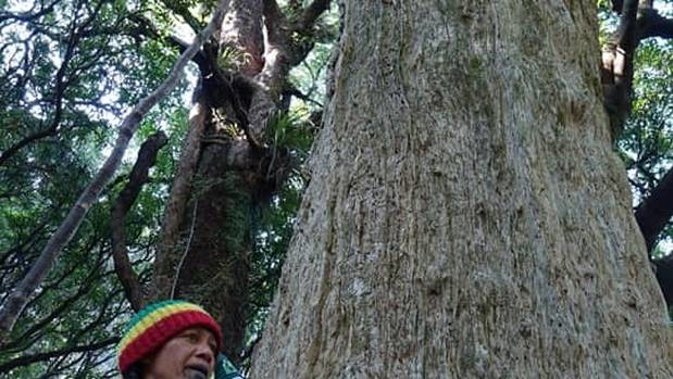
The heart of the Raukumara Forest Park should be full of lush native trees and teeming with native birds. Instead, it is silent.
Possums have savaged the trees, leaving 1000-year-old giants of the forest to die slow deaths.
Deer have been doing the groundwork, hoovering up the understory both destroying the forest's future, and an important food source of berries and seeds for native birds and insects.
Rats have been eating seeds and bird eggs, and stoats killing chicks in their nests. The lack of forest is drying up the land too, leading to erosion.
"The forest is dying," Department of Conservation ranger Graeme Atkins said.
Atkins, of Ngāti Porou descent, has been documenting the decline of the remote East Coast forest for the past 30 years, both as a keen hunter and in DoC surveys.
"It is bloody depressing work. When I first started, there was a glorious understorey, it was one of the last tracts of the country not invaded by red deer. It began to vanish before my eyes."
DoC spent about $250,000 a year controlling red deer and goats over 30,000ha in the park, but there was no possum control.
Discussions about what to do about it had become heated in the predominantly Māori East Coast communities, which contained many keen hunters.
In a bid to show the community the reality of what they were up against and promote rational discussion about pest control, Atkins selected 15 Ngāti Porou community members to join him for a night in the heart of the ngāhere.
DoC provided up to $20,000 to helicopter the group in.
"I wanted them to walk in my shoes," Atkins said.
"They all thought it would be this magical place, with pristine bush, bulging with birds, deafening dawn chorus. They all got a reality slap in the face."
In the two days they saw no kererū, tūī or bellbirds. Instead of a deafening dawn chorus, it was silent.
In most places the understorey was completely gone. They saw hundreds of dead tōtara, including one giant estimated to be nearly 1000 years old.
"Seeing that made the tears flow," Atkins said.
He had seen it all before, but the group was left devastated.
Te Runanganui o Ngāti Porou trustee Tui Warmenhoven said the visit highlighted the challenges they faced.
"The issues are clear: decimated understory, deathly silence, collapsing ecosystem."
The visit was the first stage for the iwi in terms of considering pest control options, Warmenhoven said.
"We are in the very early stages, and have no strategy as yet."
Raukumara Forest Park, established in 1979, covered 115,000ha of extremely rugged and remote, bush-clad land.
/arc-anglerfish-syd-prod-nzme.s3.amazonaws.com/public/SSGC5UOYSFHCPAO55NWI5UQX5U.jpg)
Lisa Beach with one of hundreds of dead totara being savaged by possums in the Raukumara Forest Park. (Photo / Graeme Atkins)
Iwi including Ngāti Porou, Te Whānau-ā-Apanui, Te Ehutu, Ngāi Tai, Whakatōhea and Te Aitanga-ā-Mahaki, and affiliated hapū, have occupied and continued to maintain mana whenua on all flanks of the ranges.
DoC, which administers the park, was working on a co-ordinated approach regarding its management.
The last large-scale possum control operation was 20 years ago involving aerial application of 1080 pesticide. The region was free of tuberculosis (TB), which was partly why there had been little 1080 focus. There had also been strong local opposition.
After the tour, Atkins said the group was more open to options regarding pest control.
"In this group we had some pretty hardcore hunters. Some people think the pests in there can be controlled by hunting, or trapping. After the trip they were all pretty resolute that manpower was not going to fix all of it.
"Where we were is so remote and steep it will kill you if you don't know what you are doing."
Pest control options included increasing hunting of deer, and trapping in easy-to-access areas.
But in those really remote places, Atkins said there needed to be a discussion around 1080 targeting possums.
"It is another world out there. Hunting, trapping, that's not going to save it.
"I love hunting, but not at the cost the environment is paying at the moment.
"At this rate there won't be any animals left to hunt, if the forest is gone. And we are not talking about targeting the front of the forest, only the middle, where nobody goes."
On a survey trip in November last year, Atkins and a colleague counted 200 dead tōtara.
"We stopped counting because it got so depressing."
Possums could eat up to 300g of foliage a day, and left unimpeded could do enough damage trees couldn't recover.
Atkins was frustrated at the attacks of "keyboard warriors" who shut down any reasonable discussion about pest control.
It had got nasty, with verbal and physical threats targeted at anybody appearing to support 1080.
It had got so bad East Coast environmental and indigenous rights advocate Tina Ngata established a website Ngāhere Justice, with an open letter denouncing all hate speech or acts of violence in relation to 1080.
The group called on communities to peacefully bind together to find solutions that would work for both hunting and conservation.
Atkins said the tour was designed to promote "rational" discussion in the community about pest control, before it was too late.
He was organising another trip into the forest for government officials and iwi later this year.
Marae's story on the topic airs this Sunday at 10am on TVNZ 1.
Take your Radio, Podcasts and Music with you









